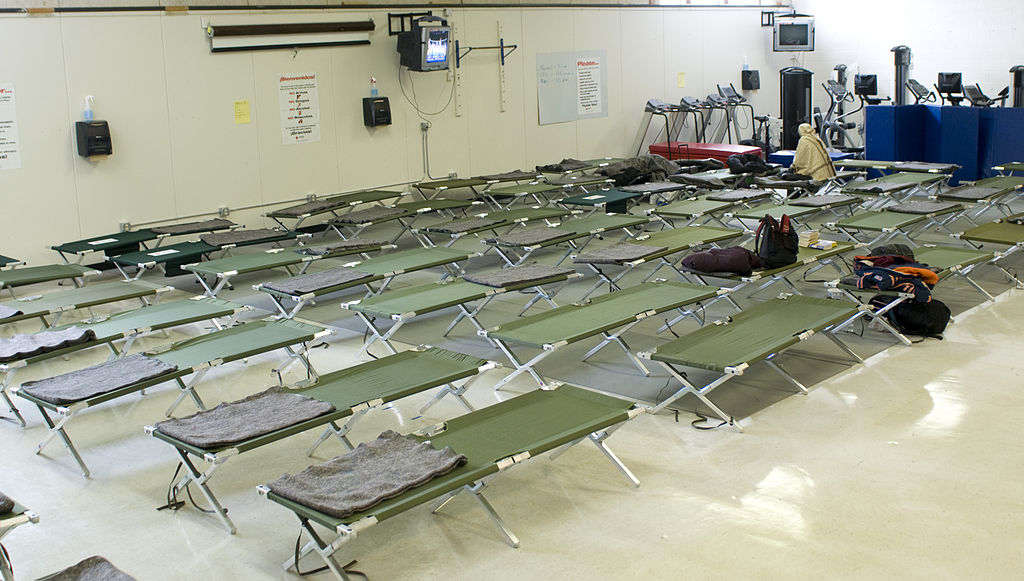2nd & D. That’s how most people who have stayed there refer to the John L. Young Women’s Shelter. It’s one of those places you occasionally hear someone trying to build up their street rep brag about. However, I don’t know whether the “harshness” of the place is all that impressive. D.C.’s resources surpass anything available in the surrounding area, yet the need exceeds anything this city can provide. John L. Young is often the starting point for those facing homelessness in DC. Perhaps it’s the easiest
shelter to get into. Nevertheless, doing so is a chore.
The first hurdle is not to become disheartened while waiting in line. Even if you arrive one hour before the doors open, that hour can easily seem like three. This is where you start classifying everyone around you. This one never talks; this one only talks to herself; this one usually just scowls, but if she does say anything, it’s usually at the top of her voice; this one glares at you; this one’s exchanges are more in the nature of performances…
If you took your time, you’d probably come up with ten different groupings, maybe more. Don’t get me wrong; if you took the time to listen, I’m sure each person would tell a unique story. But let’s be real: your situation is too much to deal with at the moment. Not too many people are stupid enough to go there. Or, perhaps I should say that not too many who will eventually get out of there are stupid enough to go there. For those determined to “fix,” or at least improve their situation, focusing on their problem is definitely the order of the day.
Anyway… if your courage holds up, and you actually get to the point of entering the building, the
first thing you’ll have to do is open your bags or your luggage. Everything is searched… Scis- sors? – gone… Razors? – gone… Nail pol- ish? – gone.
How smoothly this process goes de- pends on 1) the attitudes of those being submitted to this search and 2) the level of hostility coming from security personnel. I was lucky. During my stay, security was pretty good. (Nice people.)
Okay… assuming the most optimistic outcome (for the newcomer, anyway): one of the regulars missed the curfew, so, you have yourself a bed (probably an upper bunk). – For those who’ll have to try again tomorrow, Union Station’s bathrooms are fairly easy to access. – Relief overtakes you to the point of get- ting giddy or emotional, depending on your level of exhaustion.
Now the paperwork begins. After about what feels like an hour of giving a stranger way too many details about your recent life right there at the front desk (you are sitting, so you don’t quite feel like you’re yelling your business from a mountain top), you are given verbal and written information, a bed number, and sent on your way.
The dorm is basically a warehouse-sized room filled with steel bunks. Once you’ve found your bunk ( a challenge in itself), you prep your bed with the linen that’s been deposited on your mat, and do your best to make yourself at home, all the while stealing glances at your new neighbors.
You will also see a table a few feet away where dinner is served, a few long tables to eat at, and a television with a few folding chairs around it. The bath- rooms are to the left.
With any luck, there will be a male staff member around. Let me be clear: I’m as much a feminist as you can get without screaming or carrying a poster around, but from personal experience, I’ve found that one sensible man is worth five stern women as far as maintaining some form of order is concerned.
If you don’t need to go to the rest- room, you’ll make your way to the serving table if dinner has begun. Seconds are served only after everyone has had a chance to eat.
By this time, a couple of scenes have unfolded. Perhaps the social worker, or even the facility director, has had to emerge from her office to handle the situation. I’ve received social services in the D.C. area for about 18 months. Wanda, who worked in that office when I was at 2nd & D, was the best social worker I saw in those 18 months.
Her job seemed impossible. But she pulled it off admirably. I never heard negative words in reference to her, an accomplishment that to my knowledge has yet to be duplicated. She actually LISTENED, and displayed a decent amount of understanding without get- ting emotional. She made it a point never to allow herself to get friendly and chatty with clients, and she remained impartial. Remarkable.
I could go on, but since I must keep this to 1,000 words, I’ll limit it to this: You will find yourself in the center of a few dramas, regardless of your disposition. You might find your background and ethnic group has more to do with it than anything else. While receiving social services in DC, you’ll find that the African-American culture is the main- stream society in which you’ll have to function, or at least deal with. I’ve received more than a couple of threats, and have been referred to as a “white devil.” How well-trained a facility’s staff members are and what their sentiments are will determine how skillful you will have to be to respond to the situation.
As all this might suggest, I do not recommend John L. Young to anyone. Yet I still carry John L. Young’s number in my coin purse.
Adrienne Harris is a student at University of the District of Columbia. She stayed at John L. Young Shelter a year ago when she was homeless. She now has housing.








